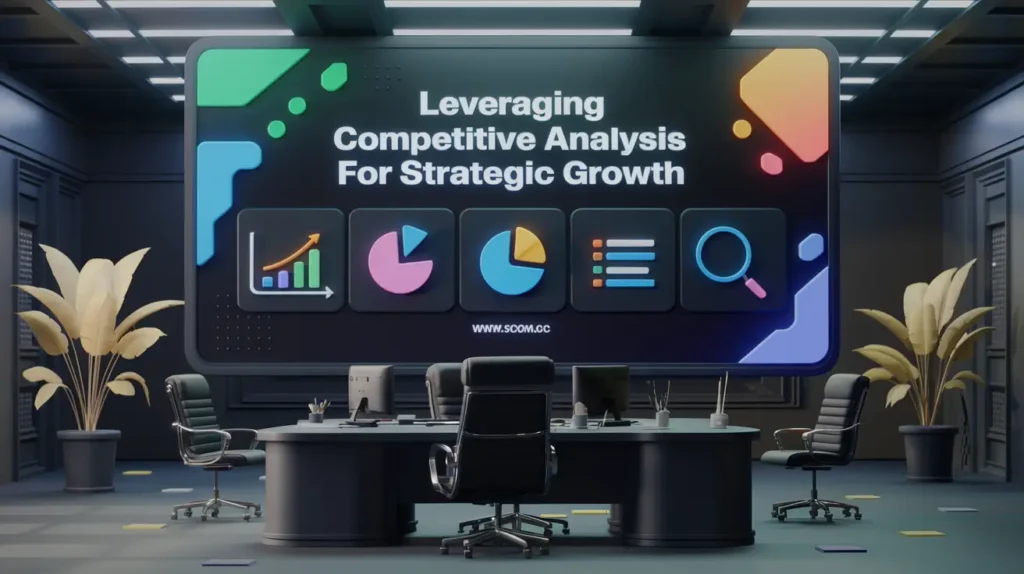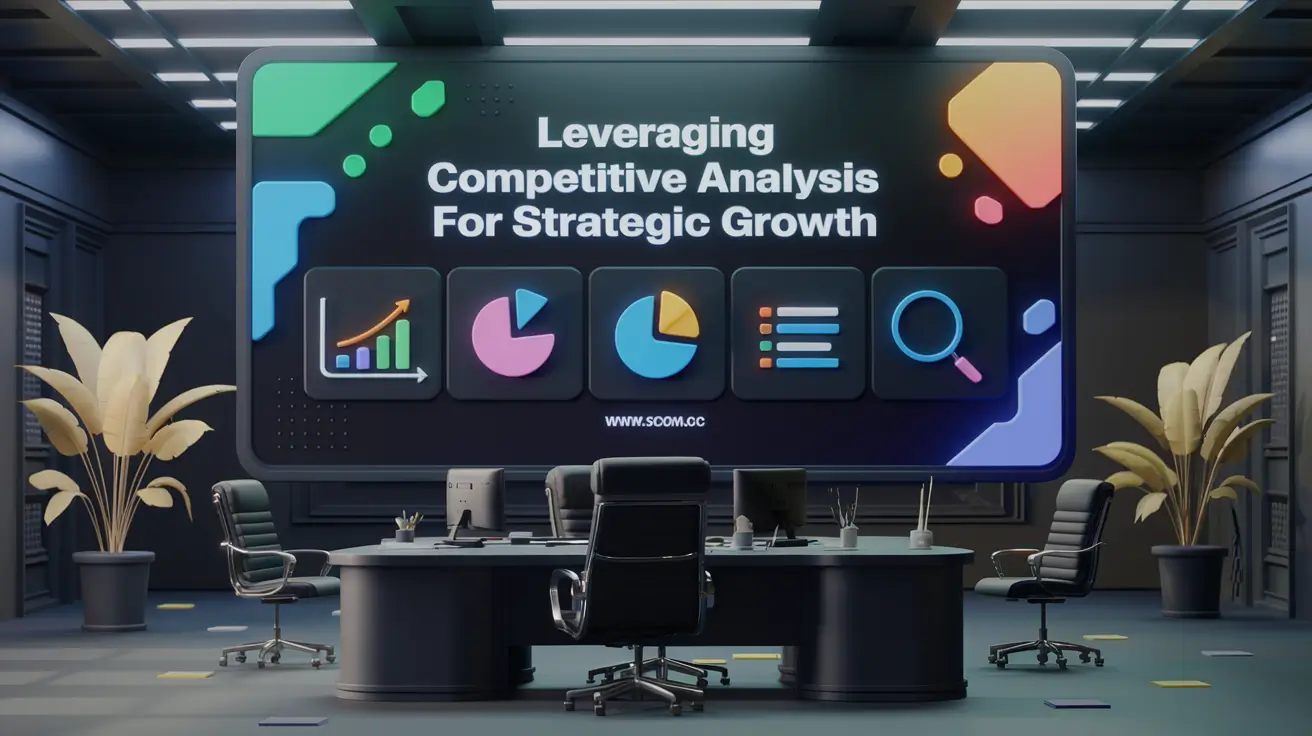Leveraging Competitive Analysis for Strategic Growth

- Leveraging Competitive Analysis for Strategic Growth
- 1. Understanding the Importance of Competitive Analysis
- 2. Identify Your Key Competitors
- 3. Analyze Competitors’ Strengths and Weaknesses
- 4. Examine Competitors’ Marketing Strategies
- 5. Monitor Competitors’ Innovation and Product Development
- 6. Benchmark Performance Against Competitors
- 7. Turn Insights into Actionable Strategies
- Conclusion: Harnessing Competitive Analysis for Success
Leveraging Competitive Analysis for Strategic Growth
In today’s fast-paced and highly competitive business environment, the ability to effectively analyze and respond to your competitors is essential for driving strategic growth. Competitive analysis provides valuable insights into your competitors’ strengths, weaknesses, strategies, and market positioning, allowing you to make informed decisions that can enhance your competitive edge. In this article, we’ll explore how to leverage competitive analysis for strategic growth, offering practical steps and actionable insights.
1. Understanding the Importance of Competitive Analysis
Competitive analysis is more than just observing what your rivals are doing—it’s about understanding the market landscape and identifying opportunities to differentiate your business. By analyzing your competitors, you can:
- Identify Market Trends: Understand the broader industry trends that are shaping the competitive landscape.
- Spot Opportunities: Discover gaps in the market or weaknesses in your competitors that you can exploit.
- Enhance Decision-Making: Use data-driven insights to make informed strategic decisions.
- Mitigate Risks: Anticipate competitive moves and prepare to counteract them.
A well-executed competitive analysis enables your business to stay ahead of the curve and capitalize on strategic opportunities.
2. Identify Your Key Competitors
The first step in leveraging competitive analysis is to identify your key competitors. These are the companies that directly compete with you for market share, customers, and resources. It's essential to distinguish between direct competitors (those offering similar products or services) and indirect competitors (those meeting the same customer needs in different ways).
How to Identify Key Competitors:
- Market Research: Conduct thorough market research to identify companies that compete in your space.
- Customer Feedback: Engage with your customers to understand who they view as alternatives to your business.
- Online Tools: Use competitive analysis tools like SEMrush, Ahrefs, and SimilarWeb to identify competitors based on keywords, market positioning, and traffic sources.
By identifying your key competitors, you can focus your analysis on the players that matter most to your strategic growth.
3. Analyze Competitors’ Strengths and Weaknesses
Once you’ve identified your key competitors, the next step is to conduct a SWOT analysis (Strengths, Weaknesses, Opportunities, Threats). This allows you to understand what your competitors do well and where they fall short, providing valuable insights into how you can position your business for success.
Key Areas to Analyze:
- Product Offerings: Compare your competitors' products or services in terms of quality, features, pricing, and innovation.
- Market Positioning: Examine how competitors position themselves in the market—what is their unique selling proposition (USP)?
- Customer Service: Assess the quality of their customer service, including responsiveness, support channels, and customer satisfaction.
- Brand Perception: Analyze brand reputation, online reviews, and social media presence to understand how customers perceive your competitors.
- Financial Health: If available, review financial reports to gauge competitors’ financial stability and investment capacity.
SWOT Example:
- Strengths: Strong brand recognition, innovative product features.
- Weaknesses: High prices, limited customer support options.
- Opportunities: Expanding into untapped markets, enhancing digital presence.
- Threats: New market entrants, changing consumer preferences.
Understanding your competitors' strengths and weaknesses allows you to position your business more effectively and capitalize on opportunities for growth.
4. Examine Competitors’ Marketing Strategies
Marketing is a key battleground in the competitive landscape. By analyzing your competitors' marketing strategies, you can identify what works, what doesn’t, and where opportunities lie for your business to differentiate itself.
Key Marketing Elements to Analyze:
- Target Audience: Who are your competitors targeting? How well do they understand and engage with their audience?
- Channels and Tactics: Which marketing channels (e.g., social media, SEO, email marketing) are they using, and how effective are these tactics?
- Content Strategy: What type of content do they produce, and how does it resonate with their audience? Analyze blogs, videos, social media posts, and more.
- Ad Spend and Campaigns: If possible, track competitors' advertising efforts—what platforms are they using, and what is their messaging?
How to Leverage Insights:
- Differentiate Your Messaging: Craft a unique value proposition that sets your brand apart from competitors.
- Optimize Marketing Channels: Focus on channels where your competitors are underperforming or where you can offer a superior experience.
- Enhance Content Strategy: Create content that addresses gaps in competitors' offerings or provides more value to your audience.
By dissecting competitors' marketing strategies, you can refine your approach to better reach and engage your target audience.
5. Monitor Competitors’ Innovation and Product Development
Innovation is a driving force behind competitive advantage. Keeping a close eye on your competitors’ product development and innovation efforts can help you anticipate industry shifts and respond proactively.
How to Monitor Innovation:
- Track New Product Launches: Stay informed about new products, features, and services that competitors introduce.
- Patents and R&D: Research patents and R&D activities to gauge competitors' focus areas and future innovations.
- Customer Feedback: Analyze customer reviews and feedback on competitors’ products to identify strengths and areas for improvement.
- Collaborations and Partnerships: Observe strategic partnerships and collaborations that may enhance competitors' innovation capabilities.
How to Leverage Insights:
- Accelerate Your R&D: Use insights from competitors’ innovation efforts to inform your own product development strategy.
- Differentiate Through Innovation: Identify opportunities to innovate in ways that competitors haven’t explored, offering something unique to the market.
- Stay Agile: Be prepared to pivot your strategy in response to competitors’ new offerings.
Monitoring your competitors' innovation and product development keeps your business at the forefront of industry trends and helps you maintain a competitive edge.
6. Benchmark Performance Against Competitors
To fully leverage competitive analysis for strategic growth, it's essential to benchmark your performance against that of your competitors. This allows you to identify areas where you are excelling and areas that need improvement.
Key Metrics to Benchmark:
- Market Share: Compare your market share to that of your competitors. Are you gaining or losing ground?
- Revenue and Profitability: How do your financial metrics stack up against competitors? Are you more or less profitable?
- Customer Satisfaction: Analyze customer satisfaction scores and net promoter scores (NPS) relative to your competitors.
- Operational Efficiency: Compare key operational metrics, such as cost per acquisition, production efficiency, and supply chain performance.
How to Use Benchmarking Insights:
- Set Improvement Goals: Identify areas where you lag behind competitors and set specific goals for improvement.
- Leverage Strengths: Focus on areas where you outperform competitors to further solidify your market position.
- Continuous Monitoring: Regularly benchmark your performance to ensure you remain competitive and agile in a rapidly changing market.
Benchmarking helps you maintain a realistic perspective on your business performance and identify areas for strategic growth.
7. Turn Insights into Actionable Strategies
Competitive analysis is only valuable if it leads to actionable strategies that drive growth. Once you’ve gathered insights from your competitive analysis, it’s time to translate them into concrete steps that enhance your strategic positioning.
Steps to Turn Insights into Action:
- Prioritize Opportunities: Focus on the most impactful opportunities identified through your analysis.
- Develop Action Plans: Create detailed action plans that outline the steps, resources, and timelines needed to execute your strategies.
- Align with Business Goals: Ensure that your competitive strategies are aligned with your broader business objectives.
- Monitor and Adjust: Continuously monitor the impact of your strategies and be willing to adjust them as needed based on market changes and new competitive insights.
Turning insights into actionable strategies is the final, crucial step in leveraging competitive analysis for strategic growth.
Conclusion: Harnessing Competitive Analysis for Success
Competitive analysis is a powerful tool for driving strategic growth in any business. By thoroughly understanding your competitors, analyzing their strengths and weaknesses, and benchmarking your performance, you can identify opportunities for differentiation and make informed decisions that propel your business forward. The key to success lies in not just gathering data, but in translating insights into actionable strategies that align with your business goals.

If you enjoyed this article and found it valuable, we encourage you to explore our news and valuable information section, where you'll find more relevant and up-to-date content that may pique your interest. Additionally, if you are seeking advice or need guidance on a specific topic, we suggest visiting our services section. There, you will find a variety of options designed to assist and support you in addressing your needs. Feel free to check out both sections to get the information and assistance that best suits your requirements.

Leave a Reply